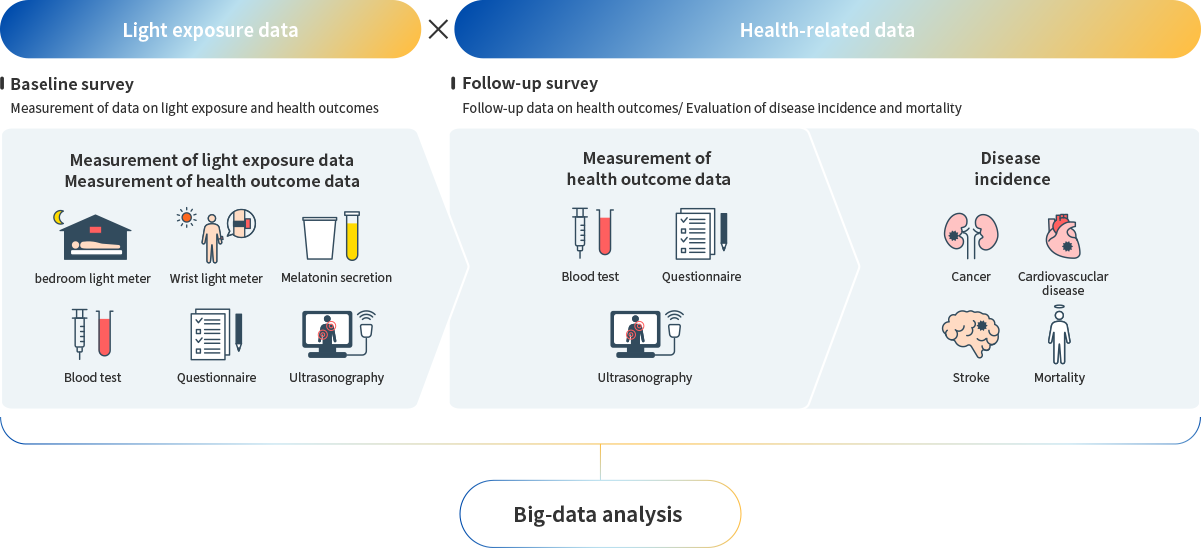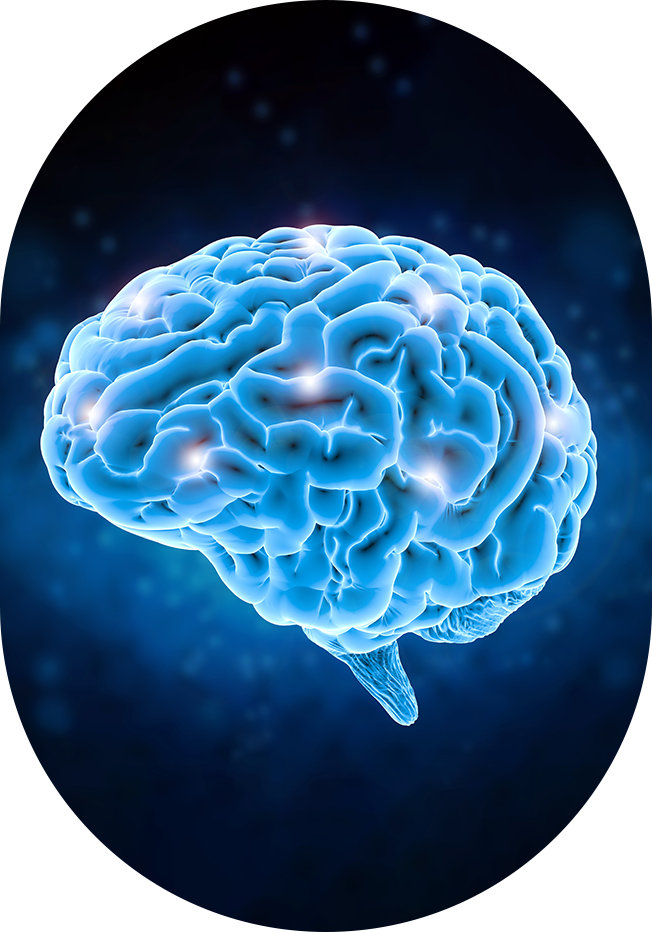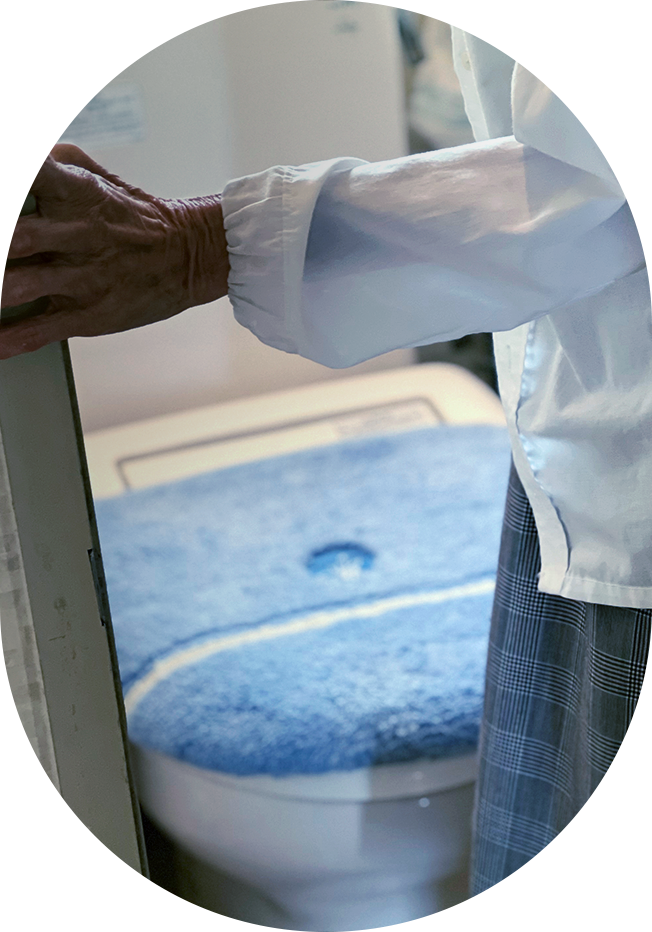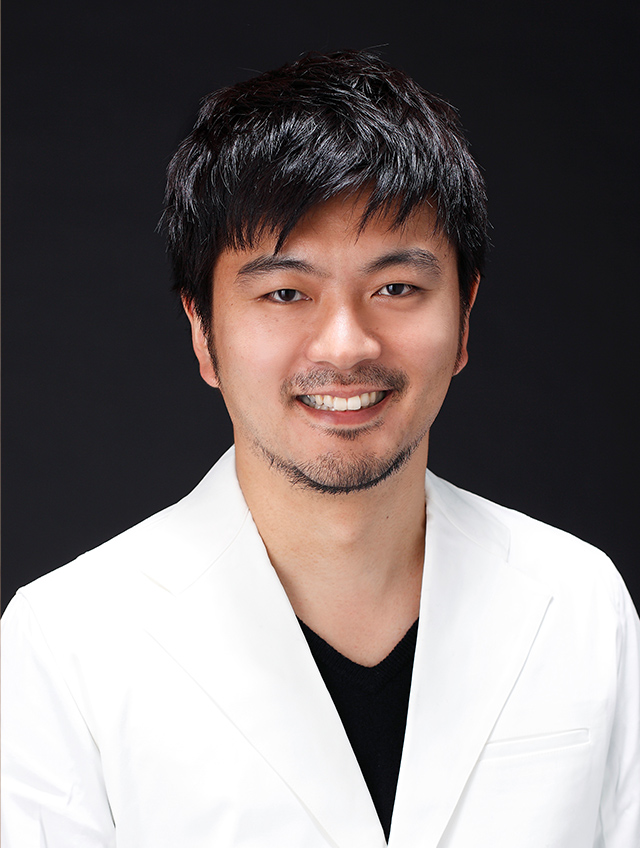MISSION
Revealing the effects of light exposure on human health
Light information enters through the eyes and is processed as time information by the central clock (SCN) in the brain. Neurotransmitters and hormones such as melatonin synchronize the time of peripheral clocks in the internal organs with the central clock. This circadian timing system allows our bodies to always be in the optimum condition for the external environment.
How much light are we exposed to in daily life? How about light levels in the bedroom? What effect does light have on human health? Believe it or not, we didn't even have the data to know these things.
Our research team is the first to measure large-scale light exposure data in daily life and analyze its health effects using epidemiological methods. So far, we have reported some new findings. In the future, we will proceed with further analysis and clarify how to be exposed to light to prevent diseases.
METHODS
Statistically analyzing of big-data obtained in our epidemiological research

A prospective cohort study is conducted to clarify the health effects of light exposure. Briefly describe the research method.
A baseline survey of 3012 adults was conducted over ten years from 2010. To measure light exposure in daily life, daytime light was measured using a wrist light meter. Light exposure at night (LAN) was measured using a bedroom light meter. At the same time, blood tests and questionnaires, carotid ultrasound and actigraphy were performed. Since then, we have been conducting annual surveys to track their health condition. Once every few years, a health check-up, including body measurements, blood tests, and ultrasound examinations. We also conduct long-term studies of disease incidence and mortality.
Statistical analysis of these big data reveals "How we are exposed to light will lead to a healthy life."
ACTIVITIES
01 Reaserch on light exposure
The human biological rhythms are strongly affected by light exposure. We measured light exposure levels continiously in big samples, and we try to reveal how much, what color, what timing of light people are exposed to in modern society. Importantly, we scientifically analyze the relationship between light exposure and various health data and desease incidence. In the future, we will proceed with further analysis and clarify how to be exposed to light to prevent diseases.
-
Related articles
1. Obayashi K, Tai Y, Yamagami Y, Saeki K. Associations between Indoor Light Pollution and Unhealthy Outcomes in 2,947 Adults: Cross-Sectional Analysis in the HEIJO-KYO Cohort. Environ Res, 215 114350, Dec, 2022. 2. Obayashi K, Yamagami Y, Tatsumi S, Kurumatani N, Saeki K. Indoor Light Pollution and Progression of Carotid Atherosclerosis: A Longitudinal Study of the HEIJO-KYO Cohort. Environ Int, 133 105184, Dec, 2019. 3. Obayashi K, Saeki K, Kurumatani N. Bedroom Light Exposure at Night and the Incidence of Depressive Symptoms: A Longitudinal Study of the HEIJO-KYO Cohort. Am J Epidemiol, 187(3) 427-434, Mar, 2018. 4. Obayashi K, Saeki K, Kurumatani N. Ambient Light Exposure and Changes in Obesity Parameters: A Longitudinal Study of the HEIJO-KYO Cohort. J Clin Endocrinol Metab, 101(9) 3539-3547, Sep, 2016. 5. Obayashi K, Saeki K, Iwamoto J, Okamoto N, Tomioka K, Nezu S, Ikada Y, Kurumatani N. Positive Effect of Daylight Exposure on Nocturnal Urinary Melatonin Excretion in the Elderly: A Cross-sectional Analysis of the HEIJO-KYO Study. J Clin Endocrinol Metab, 97(11) 4166-4173, Nov, 2012.

02 Reaserch on melatonin excretion
Melatonin is a hormone secreted by the pineal gland at night, and is deeply involved in regulating biological rhythms and sleep. When exposed to light at night, melatonin secretion is suppressed, causing disturbances in biological rhythms and sleep disorders. Melatonin is known to have various physiological effects, such as lowering blood pressure, suppressing carcinogenesis, antioxidant, tranquilizing, and stimulating the immune system, but there are currently few large-scale studies. Our research team has measured the urinary metabolites of melatonin in more than 3,000 adults and is studying their relationship with health data and disease development.
-
Related articles
1. Obayashi K, Saeki K, Iwamoto J, Tone N, Tanaka K, Kataoka H, Morikawa M, Kurumatani N. Physiological Levels of Melatonin Relate to Cognitive Function and Depressive Symptoms: The HEIJO-KYO Cohort . J Clin Endocrinol Metab, 100(8) 3090-3096, Aug, 2015. 2. Obayashi K, Saeki K, Kurumatani N. Higher Melatonin Secretion is Associated with Lower Leukocyte and Platelet Counts in the General Elderly Population: The HEIJO-KYO Cohort. J Pineal Res, 58(2) 227-233, Feb, 2015. 3. Obayashi K, Saeki K, Kurumatani N. Association between Urinary 6-sulfatoxymelatonin Excretion and Arterial Stiffness in the General Elderly Population: The HEIJO-KYO Cohort. J Clin Endocrinol Metab, 99(9) 3233-3239, Sep, 2014.

03 Reaserch on sleep
Sleep is full of many mysteries, but recent advances in sleep research have revealed a wide variety of things. Several wearable devices are developed that can easily and objectively measure sleep quality. Our research team measures objective sleep indices in large populations and studies their association with health data and disease development. More than half of the elderly suffer from sleep problems. It is very important to find new risk factors for sleep disorders, and we believe that our data will provide basic information for new treatment methods.
-
Related articles
1. Kataoka H, Saeki K, Yamagami Y, Sugie K, Obayashi K. Quantitative Associations between Objective Sleep Measures and Early-Morning Mobility in Parkinson’s Disease: Cross-Sectional Analysis of the PHASE Study. SLEEP, 43(1), Jan, 2020. 2. Oume M, Obayashi K, Asai Y, Ogura M, Takeuchi K, Tai Y, Kurumatani N, Saeki K. Objective Sleep Quality and Nighttime Blood Pressure in the General Elderly Population: A Cross-Sectional Study of the HEIJO-KYO Cohort. J Hypertens, 36(3) 601-607, Mar, 2018. 3. Obayashi K, Kurumatani N, Saeki K. Gender Differences in the Relationships between Chronic Kidney Disease, Asymmetric Dimethylarginine, and Sleep Quality:The HEIJO-KYO Cohort. Nitric Oxide, 79(9) 25-30, Sep, 2018.

04 Reaserch on nocturia
With aging, the number of times you go to the bathroom at night increases. Nearly half of the elderly suffer from nocturia, which involves going to the toilet more than once at night, and it is essential to identify the new risk factors and know the health effects. Our research team has obtained large-scale data on nocturnal urine volume and nocturnal void frequency, and has reported new findings so far. We are continuing our research with the goal of reducing as many people as possible who suffer from nocturia.
-
Related articles
1. Obayashi K, Saeki K, Kurumatani N. Association between Melatonin Secretion and Nocturia in Elderly Individuals: A Cross-Sectional Study of the HEIJO-KYO Cohort. J Urol, 191(6) 1816-1821, Jun, 2014. 2. Obayashi K, Saeki K, Negoro H, Kurumatani N. Nocturia Increases the Incidence of Depressive Symptoms: A Longitudinal Study of the HEIJO-KYO Cohort. BJU Int, 120(2) 280-285, Aug, 2017. 3. Obayashi K, Saeki K, Kurumatani N. Quantitative Association between Nocturnal Void Frequency and Objective Sleep Quality in the General Elderly Population: The HEIJO-KYO Cohort. Sleep Med, 16(5) 577-582, May, 2015.

05 Other research
As a co-researcher, I'm involved in many other studies besides "light," "melatonin," "sleep," and "nocturia."
・Data science of temperature environment (Dr. Keigo Saeki, Nara Medical University School of Medicine)
・Data science of skin temperature (Dr. Yoshiaki Tai, Nara Medical University School of Medicine)
・Data science of noise environment and physical activity (Dr. Yuki Yamagami, Nara Medical University School of Medicine)
・Data science of Parkinson's disease (Dr. Hiroshi Kataoka, Nara Medical University School of Medicine)
・Data science of glaucoma and cataract (Dr. Masanobu Yoshikawa, Nara Medical University School of Medicine)
・Data science of bipolar disorder (Dr. Yuichi Ezaki, Fujita Health University School of Medicine)
・Data science of hospital room environment (Dr. Junko Iwamoto, Nara Medical University School of Medicine)
In these studies, large-scale data on environmental factors and biological information are acquired, and the relationship with disease onset and disease stage progression is studied.
-
Related articles
1. Yamagami Y, Obayashi K, Tai Y, Saeki K. Association between Indoor Noise Level at Night and Objective/Subjective Sleep Quality in the Older Population: A Cross-Sectional Study of the HEIJO-KYO Cohort. SLEEP, (in press), Aug, 2022. 2. Saeki K, Obayashi K, Iwamoto J, Tanaka Y, Tanaka N, Takata S, Kubo H, Okamoto N, Tomioka K, Kurumatani N. Influence of Room Heating on Ambulatory Blood Pressure in Winter: A Randomised Controlled Study. J Epidemiol Community Health, 67(6) 484-490, Jun, 2013. 3. Tai Y, Obayashi K, Yamagami Y, Saeki K. Inverse Association of Skin Temperature with Ambulatory Blood Pressure and the Mediation of Skin Temperature in Blood Pressure Responses to Ambient Temperature. Hypertension, 79(8) 1845-1855, Aug, 2022. 4. Obayashi K, Saeki K, Yamagami Y, Kurumatani N, Sugie K, Kataoka H. Circadian Activity Rhythm in Parkinson's Disease: Findings from the PHASE Study. Sleep Med, 85(9) 8-14, Sep, 2021. 5. Nishi T, Saeki K, Miyata K, Yoshikawa T, Ueda T, Kurumatani N, Obayashi K, Ogata N. Effects of Cataract Surgery on Melatonin Secretion in Adults 60 Years and Older: A Randomized Clinical Trial. JAMA Ophthalmol., 138(4) 405-411, Apr, 2020. 6. Yoshikawa T, Obayashi K, Miyata K, Saeki K, Ogata N. Increased Nighttime Blood Pressure in Patients with Glaucoma: Cross-Sectional Analysis of the LIGHT Study. Ophthalmology, 126(10) 1366-1371, Oct, 2019. 7. Esaki Y, Obayashi K, Saeki K, Fujita K, Iwata N, Kitajima T. Association between Circadian Activity Rhythms and Mood Episode Relapse in Bipolar Disorder: A 12-month Prospective Cohort Study. Transl Psychiatry, 11(1) 525, Oct, 2021. 8. Iwamoto J, Saeki K, Kobayashi M, Yamagami Y, Yoshida O, Kurumatani N, Obayashi K. Lower Incidence of In-Hospital Falls in Patients Hospitalised in Window Beds than Non-Window Beds. J Am Med Dir Assoc, 21(4) 476-480, Apr, 2020.

RESEARCHER

KENJI OBAYASHI, MD, PhD
Research Associate Professor at Nara Medical University School of Medicine
CEO of the Keiseikai Medical & Healthcare Group
Kenji Obayashi, MD, PhD, is a Research Associate Professor in the Department of Epidemiology, Nara Medical University School of Medicine. Dr. Obayashi earned his MD at Tokyo Medical University, and PhD at Nara Medical University, Japan. He completed post-graduate training in internal medicine and clinical fellowship in adult cardiology from Tokyo Women’s Medical University Hospital, Japan. He is board certified in internal medicine and cardiology. His primary research interest is in exploring the exposures that influence the circadian timing system in human. Thus, Dr. Obayashi’s current special interests include epidemiology related to circadian biological rhythm (Chronoepidemiology). Several of Dr. Obayashi’s studies were featured in the popular press, such as TIME, REUTERS, and Washington Post.
-
Awards
Japan Medical Association Medical Research Encouragement Prize
Japan Epidemiological Association Young Investigator's Award
Japanese Society of Chronobiology Young Investigator's Award -
Certifications
Board Certified Senior Epidemiologist of the Japan Epidemiological Association (JEA)
Board Certified Physician/Supervisory Physician for Public Health & Social Medicine of the Japan Board of Public Health and Social Medicine (JBPHSM)
Board Certified Environmental Health and Preventive Medicine Expert of the Japanese Society for Hygiene (JSH)
Board Certified Fellow of the Japanese Circulation Society (JCS)
Board Certified Sports & Health Physician of the Japan Medical Association (JMA)
Board Certified Occupational Health Physician of the Japan Medical Association (JMA)
Board Certified Fellow of the Japanese Society of Internal Medicine of the Japan Medical Association (JMA)
